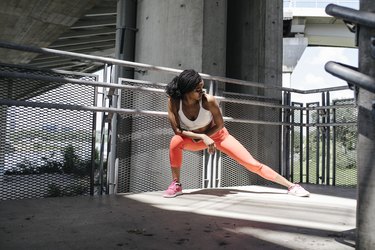
If you don't include lateral lunges on leg day, you're doing your lower limbs a disservice. This unilateral movement strengthens your glutes, quads and hamstrings while improving balance, stability and coordination, says Erica Ziel, personal trainer and host of The Core Connections Podcast.
While side lunges are seemingly straightforward (you step to the side and lower your butt), they're often performed incorrectly. And when your form is off, lateral lunges not only become less effective but also potentially painful. Here, Ziel discusses the most common mistakes, plus offers tips on how to level up your technique.
Video of the Day
First, Master Proper Side Lunge Form
- Stand with your feet together and hands at your sides.
- Take a large step out to the right, sinking your hips back and bending your right knee (it should align directly with your right ankle).
- Keep your left leg straight (but don't lock your knee), making sure both feet are parallel to each other and pointing forward. Maintain a neutral spine with your chest lifted.
- Push off the right foot and straighten your right leg as you return to standing.
- Continue for desired number of reps and repeat on the left side.
Avoid These 8 Lateral Lunge Mistakes
1. Your Knee Caves In
When the knee of your moving leg collapses inward during side lunges, this places unnecessary pressure on your joints and can cause pain, Ziel says. And over time, this improper form can even lead to injury.
Fix It
Make sure the foot, knee and hip bone of your moving leg are lined up with each other, Ziel says. And concentrate on shifting your weight back (bending at your hip rather than your knee) to engage your glutes.
2. You Slouch Your Back
Rounding your back could cause pain in your lumbar region and even your knees, Ziel says. A slouched back may also signal that you're tucking your pelvis, which can contribute to lower back discomfort and pelvic floor dysfunction, she says.
Fix It
Keep a straight spine. To avoid slumping or overarching your lower back, focus on lengthening from your tailbone through the top of your head and engaging your core muscles, she says.
3. You Hyperextend Your Neck
Do you use a mirror to watch yourself do lateral lunges? While you might think it's helping you perfect your form, it's also likely hyperextending your neck muscles. This puts a lot of pressure on your neck and lower back and prevents you from having optimal core activation, Ziel says.
Fix It
Maintain a neutral neck. “Your neck should have a slight curve only, so avoid looking up as you do your side lunges,” she says. Think about lengthening from your tailbone or pelvic floor through the top of your head.
4. You Over-Rotate Your Trunk
When you lean to one side in your lateral lunge, it's easy to over-rotate your body. But this results in taxing the wrong muscles (i.e., not your glutes and hips) and possibly putting too much strain on your knees, lower back and hip flexors, Ziel says.
Fix It
Keep your trunk squared to the front. Think about growing tall through the top of your head even when lowering, she says.
Also, focus on “keeping space above your hip joint, as this can help you stay out of your hip flexors and feel the connection coming from underneath your glutes and outer hips,” she says.
5. Your Stance Is Too Narrow
If your feet are too close after you step to the side, your knee might travel laterally past your ankle, possibly leading to knee pain, Ziel says.
Fix It
Take a wide stance with your feet parallel with each other. “You want to be able to have enough space to move laterally back and forth with your legs staying in alignment from your feet, knees and sits-bones,”she says.
6. You Tuck Your Butt
While lateral lunges target your butt, hamstrings and hips, you should never try to activate the muscles by tucking your tailbone. It can force you to grip your glutes, which can contribute to knee discomfort, lower back pain and pelvic floor dysfunction, Ziel says.
Fix It
Again, imagine long and lean muscles. Lengthen tall from your tailbone and pelvic floor through the top of your head, she says.
7. You Turn Your Feet Outward
"This can put a lot of pressure on your knees and prevent you from getting the best activation of your glutes," Ziel says. "And when feet are turned outward [even just a little past parallel], you may also notice your hip flexors trying to do the work," she says.
Fix It
Check the position of your feet and make sure they're parallel to each other, Ziel says. Even turning the toes a tad inward is fine.
“You may find that having your feet slightly turned inward helps you feel your glutes working more easily and keeps any pressure/pain out of your knees,” she says.
8. You Put All the Weight in Your Heels or the Outside of Your Feet
When performing squats, you've probably heard the cue to keep your weight in your heels. But with lateral lunges, you'll enhance the activation of your hamstrings and the underside of your glutes when your weight is evenly distributed through your foot, Ziel says.
Fix it
Focus on keeping your weight as evenly distributed as you can. “This means that you should feel some weight under the balls of your foot and even your toes (specifically your big toe),” she says.